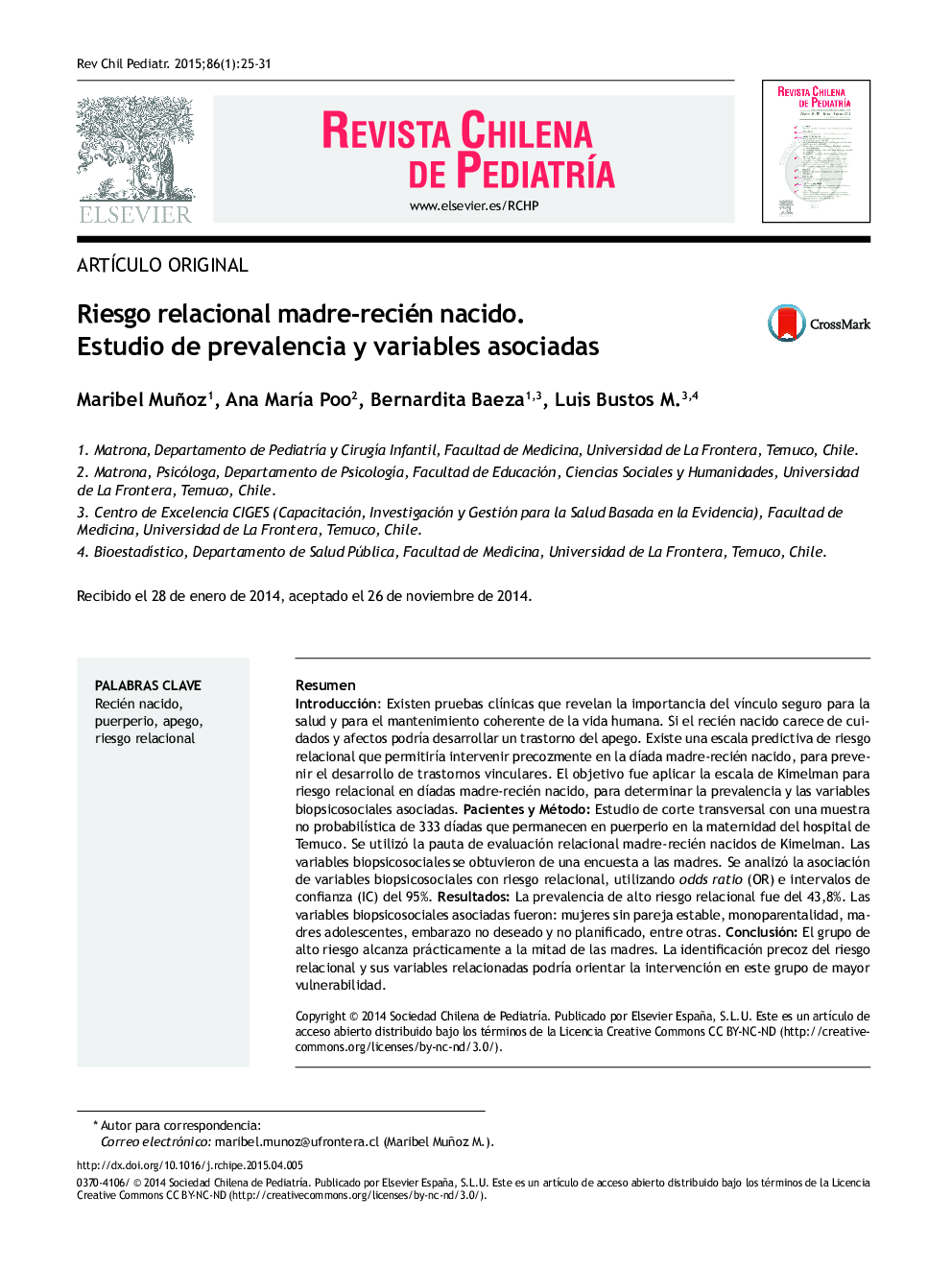| کد مقاله | کد نشریه | سال انتشار | مقاله انگلیسی | نسخه تمام متن |
|---|---|---|---|---|
| 4175864 | 1276222 | 2015 | 7 صفحه PDF | دانلود رایگان |

ResumenIntroducciónExisten pruebas clínicas que revelan la importancia del vínculo seguro para la salud y para el mantenimiento coherente de la vida humana. Si el recién nacido carece de cuidados y afectos podría desarrollar un trastorno del apego. Existe una escala predictiva de riesgo relacional que permitiría intervenir precozmente en la díada madre-recién nacido, para prevenir el desarrollo de trastornos vinculares. El objetivo fue aplicar la escala de Kimelman para riesgo relacional en díadas madre-recién nacido, para determinar la prevalencia y las variables biopsicosociales asociadas.Pacientes y MétodoEstudio de corte transversal con una muestra no probabilística de 333 díadas que permanecen en puerperio en la maternidad del hospital de Temuco. Se utilizó la pauta de evaluación relacional madre-recién nacidos de Kimelman. Las variables biopsicosociales se obtuvieron de una encuesta a las madres. Se analizó la asociación de variables biopsicosociales con riesgo relacional, utilizando odds ratio (OR) e intervalos de confianza (IC) del 95%.ResultadosLa prevalencia de alto riesgo relacional fue del 43,8%. Las variables biopsicosociales asociadas fueron: mujeres sin pareja estable, monoparentalidad, madres adolescentes, embarazo no deseado y no planificado, entre otras.ConclusiónEl grupo de alto riesgo alcanza prácticamente a la mitad de las madres. La identificación precoz del riesgo relacional y sus variables relacionadas podría orientar la intervención en este grupo de mayor vulnerabilidad.
IntroductionClinical evidence reveals the importance of mother-newborn bonding experience for health promoting and maintenance of human life. If the newborn lacks care and affection, she/he may develop an attachment disorder. A predictive scale regarding the risk of mothernewborn relationships is available, which makes possible an early intervention to prevent the development of relational disorders. The aim of this study is to apply the Kimelman measurement scale to determine the relational risk in mother-newborn pairs, as well as the prevalence and the associated biopsychosocial variables.Patients and MethodsA cross-sectional study with a probabilistic sample of 333 mother-infant pairs in postpartum maternity at Temuco hospital. The Kimelman mother-newborn attachment assessment guide was used. Biopsychosocial variables were obtained from the mothers studied. The association of biopsychosocial variables with relational risk was analyzed using OR and confidence intervals of 95%.ResultsThe prevalence of high relational risk was 43.8%. The associated biopsychosocial variables included, women with no steady partner, single parent, teenage mothers, unwanted and unplanned pregnancy.ConclusionAlmost half of the mothers were in the high risk group. Early identification of relational risk and its related variables could help in the intervention in this vulnerable group.
Journal: Revista Chilena de Pediatría - Volume 86, Issue 1, January–February 2015, Pages 25–31